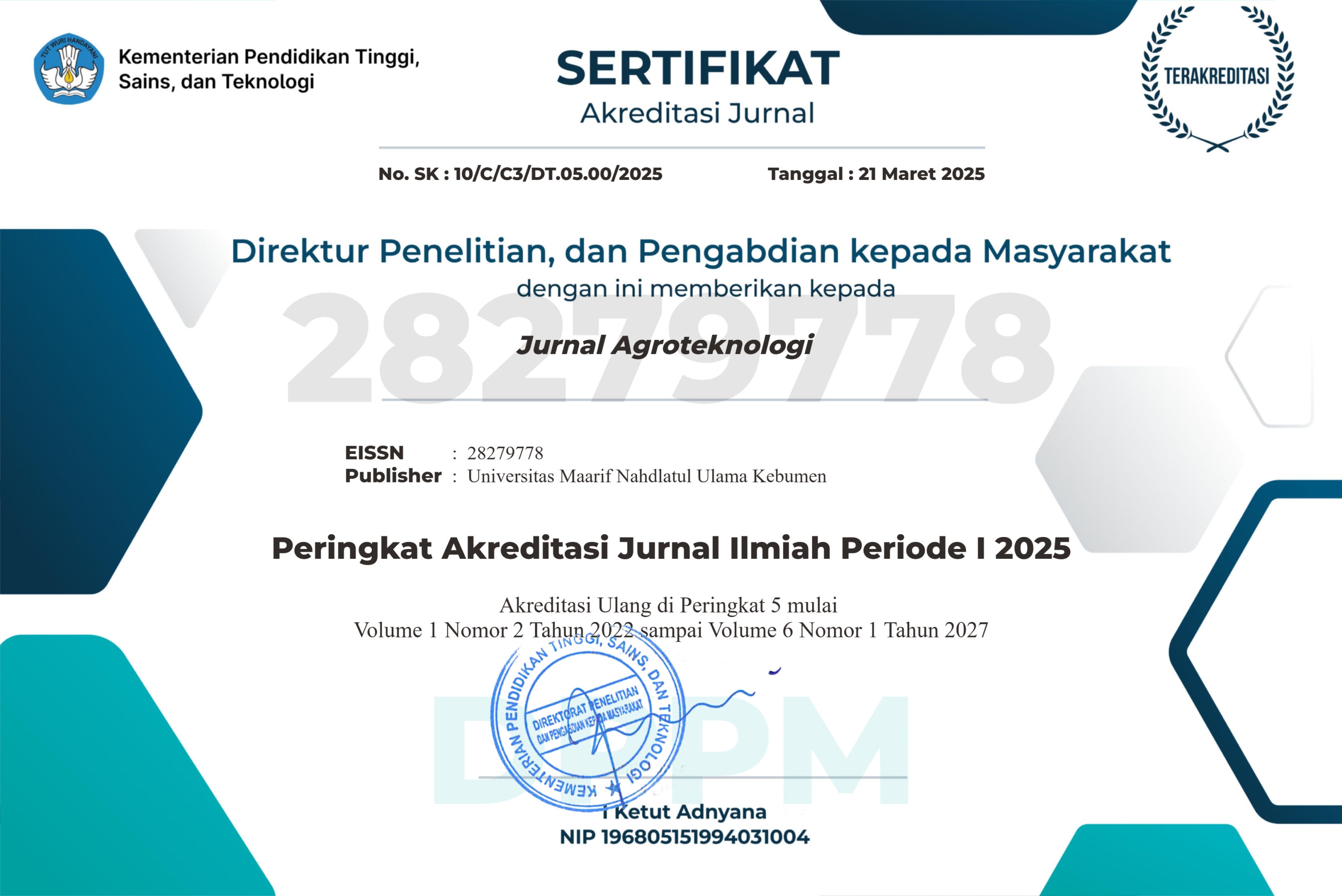Evaluasi Status Kesuburan Tanah pada Lahan Tanaman Nilam di Desa Karya Mulya Kecamatan Kulisusu Barat Kabupaten Buton Utara
DOI:
https://doi.org/10.53863/agronu.v4i01.782Keywords:
Soil Fertility, Fertilization Recommendations, Patchouli PlantsAbstract
Soil fertility is the ability of the soil to provide nutrients in balanced amounts for plant growth and production. Land cultivated for agriculture has varying levels of fertility. Proper soil management is an important factor in determining the growth and yield of cultivated plants. This study aims to describe the status of soil fertility and recommend the direction of fertilization for patchouli plants in Karya Mulya Village, West Kulisusu, North Buton. This research was conducted from December 2022 to February 2023. The method used in this study was a free survey method based on the location of the patchouli plantation. Sampling was carried out at a depth of 0-20 cm. The samples taken were analyzed in the laboratory to assess pH, organic C, available P, available K, CEC, and KB. The results of the study showed that the pH was classified as slightly acidic with a value of 6.1-6.3, low to moderate organic C with a value of 1.04-1.58%, low available P with a value of 5.98-7.59 ppm, low to moderate available K with a value of 0.29-0.42 me 100 g⁻¹, medium and high CEC with a value of 19.74-25.23 me 100 g⁻¹, low to moderate KB with a value of 38.68-43.61%. Based on the results of the assessment of soil chemical properties, it can be concluded that the level of soil fertility at the research location is low. Fertilization efforts are needed to increase the fertility of patchouli planting soil by paying attention to the right aspects in fertilization.
References
Afandi, F. N., Siswanto, B., & Nuraini, Y. (2015). Pengaruh Pemberian Berbagai Jenis Bahan Organik terhadap Sifat Kimia Tanah pada Pertumbuhan dan Produksi Tanaman Ubi Jalar di Entisol Ngrangkah Pawon, Kediri. Jurnal Tanah dan Sumberdaya Lahan, 2(2), 237-244.
Alam, S., Sunarminto, B. H., & Siradz, S. A. (2012). Karakteristik kesuburan tanah pada kondisi iklim berbeda di Sulawesi Tenggara. Agriplus, 22(1), 77-84.
Badan Standardisasi Instrumen Pertanian. (2023). Petunjuk Teknis Analisis Kimia Tanah, Tanaman, Air dan Pupuk. Kementerian Pertanian Republik Indonesia. Bogor.
Darlita, R.R., Joy, B., & Sudirja, R. (2017). Analisis Beberapa Sifat Kimia Tanah terhadap Peningkatan Produksi Kelapa Sawit pada Tanah Pasir di Perkebunan Kelapa Sawit Selangkun. Jurnal Agrikultura, 28(1), 15-20.
Ginting, R., Razali, & Nasution, Z. (2013). Pemetaan Status Unsur Hara C-Organik dan Nitrogen di Perkebun Nanas (Ananas comosus L. Merr) Rakyat Desa Panribuan Kecamatan Dolok Silau Kabupaten. Jurnal Online Agroekoteknologi, 1(4), 1308-1318.
Hanafiah, K. A,. (2005). Dasar-dasar Ilmu Tanah.Raja Grafindo Persada. Jakarta.
Handayanto, E. (2014). Pengelolaan Kesuburan Tanah. Fakulas Pertanian Universitas Brawijaya. Malang.
Muhklis. (2007). Analisis Tanah dan Tanaman. USU Press. Medan.
Mujizat, Y., Namriah, N., Leomo, S., Darwis, D., Alam, S., & Resman, R. (2023). Variabilitas Kandungan C-Organik pada Tanah Ultisol yang Diberi Berbagai Jenis Bahan Organik untuk Pertumbuhan Tanaman Sawi. Jurnal Agroteknologi (Agronu), 2(02), 82–90.
Mukhlis, S., & Hanum, H. (2011). Kimia Tanah. Teori dan Aplikasi. USU Press. Medan.
Nurhidayati. (2017). Kesuburan dan Kesehatan Tanah. Suatu Pengantar Penilaian Kualitas Tanah Menuju Pertanian Berkelanjutan. Intimedia. Malang.
Panggabean, R. J., Meiriani, & Hanum C. (2017). Respons Pertumbuhan Bibit Bud Chips Tebu terhadap Dosis dan Frekuensi Pemberian Pupuk N, P, dan K pada Wadah Pembibitan yang Berbeda. Jurnal Agroekoteknologi FP USU, 5(4), 774-779.
Panjaitan, S., & Yeni. (2014). Teknik Pengembangan Nilam (Pogostemon cablin Benth) di Kalimantan Selatan. Jurnal Galam, 7(1), 31-41.
Prabowo, R., & Subantoro, R. (2017). Analisis Tanah Sebagai Indikator Tingkat Kesuburan Lahan Budidaya Pertanian di Kota Semarang. Jurnal Ilmiah Cendekia Eksakta, 2(2), 59-64.
Pusat Penelitian Tanah. (1983). Lampiran Tor of Reference Klasifikasi Kesesuaian Lahan. No.59 b/1983. P3MT Balitbang Deptan. Bogor. 23p
Riwandi, Prasetyo, Hasanudin, & Cahyadinata. (2017). Kesuburan Tanah dan Pemupukan. Yayasan Sahabat Alam Rafflesia. Bengkulu.
Rosmarkam, A., & Yuwono. (2002). Ilmu Kesuburan Tanah. Kanisus Yogyakarta.
Saosang, S., Mambuhu, N., & Katili, H. A. (2023). Analisis Tingkat Kesuburan Tanah pada Tanaman Nilam (Pogostemon cablin) di Desa Balingara dan Desa Bella Kecamatan Nuhon. Jurnal Ilmiah Mahasiswa Fakultas Pertanian, 2(1), 155–161.
Sembiring, I.S., Wawan, & Khoiri, M.A. (2015). Sifat Kimia Tanah Dystrudepts dan Pertumbuhan Akar Tanaman Kelapa Sawit (Elasis guineensis Jacq.) yang Diaplikasikan Mulsa Organik. JOM FAPERTA, 2(2), 1-11.
Sudaryono. (2009). Tingkat Kesuburan Tanah Ultisol pada Lahan Pertambangan Batu Bara Sangatta Kaltim. Jurnal Teknologi Lingkungan, 10(3), 337-346.
Sukawati, L. (2019). Analisis Pengembangan Agribisnis Tanaman Nilam Di Kabupaten Konawe. Jurnal Akrab Juara, 4(2), 1-14.
Suleman, D., Resman, Syaf, H., Namriah, Suaib, Alam, S., Yusuf, D. N.& Mbay, W. O. N. (2024).Change of soil chemical properties and the growth of Pogostemon cablin Benth on nickel-mined soil amended with rice husk charcoal. Journal of Degraded and Mining Lands Management 11(2):5353-5360.
Sumanta, W. R., Ginting, S., Namriah, Darwis, Alam, S., & Resman. (2023). Evaluasi Status Kesuburan Tanah pada Lahan Sawah Tadah Hujan di Desa Jati Bali, Konawe Selatan. Jurnal Agroteknos, 13(3), 121- 128.
Sutanto, R. (2005). Dasar-Dasar Ilmu Tanah. Kanisius. Yogyakarta.
Downloads
Published
How to Cite
Issue
Section
License
Copyright (c) 2025 Radi Khairul Azza, Sahta Ginting, Resman Resman, Darwis Darwis, Syamsu Alam, Namriah Namriah

This work is licensed under a Creative Commons Attribution-ShareAlike 4.0 International License.
Authors retain copyright and grant the journal right of first publication with the work simultaneously licensed under a Creative Commons Attribution-ShareAlike 4.0 International License that allows others to share the work with an acknowledgment of the work’s authorship and initial publication in this journal











